
Brief 20 is also available as an Adobe PDF file.
The West Virginia Children’s Health Insurance Program (CHIP) provides coverage to uninsured children who are not eligible to receive coverage through the Medicaid program. These children are in families whose incomes are too high to qualify for Medicaid, but are less than twice that of the current Federal Poverty Level (1). CHIP enrollees are of particular interest to public health programs because many health conditions, including asthma, are inversely associated with socioeconomic indicators such as income. That is, individuals with low levels of income are more likely to have chronic health conditions. In fact, in 2003 the prevalence of asthma was nearly two times higher among West Virginia children with health care coverage through CHIP or Medicaid than children with private health insurance (15.0% vs. 8.0%) (2).
West Virginia public health programs are working to reduce socioeconomic disparities related to chronic disease and access to health care. The first step is to identify and understand the burden of disease among West Virginians of low socioeconomic status. Therefore, the West Virginia Asthma Education and Prevention Program funded a project headed by Michael Smith, Ph.D., R.Ph., at the West Virginia University School of Pharmacy to analyze West Virginia CHIP claims data from calendar year 2005 to determine: 1) the prevalence of asthma in the CHIP population, 2) asthma-related medical services and prescription utilization among CHIP enrollees, and 3) the amount reimbursed for asthma-related services and prescriptions by West Virginia CHIP. It is important to note that the methodology used in this report may overestimate the prevalence of asthma and asthma-related medical service visits and reimbursements. See the Appendix for a discussion of the study methodology and for detailed data tables.
Table 1.
Summary of Utilization of Asthma-related Health Care by West Virginia CHIP Enrollees, 2005
| TOTAL ASTHMA UTILIZATIONa | ||||
|---|---|---|---|---|
| Type of utilization | Number of enrollees with asthma |
Prevalence rate per 1,000 enrollees |
Total amount reimbursedd,e |
Avg. reimbursed per enrolleee |
| Total asthma utilization | 4,086 | 168 | $1,845,669 - $1,942,183 | $452 - $475 |
| MEDICAL VISIT UTILIZATIONb | ||||
| Type of utilization | Number of visits | Rate of visits per 10,000 enrollees |
Total amount reimbursed |
Average reimbursed per visit |
| Office/Clinic Visits | 5,725 | 2,350 | $543,404 | $95 |
| Emergency Room visits | 455 | 187 | $121,671 | $267 |
| Hospitalizations | 65 | 27 | $86,529 - $183,043 | $1,331 - $2,816 |
| PRESCRIPTION UTILIZATIONc | ||||
| Type of utilization | Number of claims for asthma-related drugs |
Average number of claims per enrollee |
Total amount reimbursed |
Average reimbursed per enrollee |
| Prescriptions | 11,089 | 5.0 | $754,343 | $340 |
| ASTHMA PREVALENCE & TOTAL REIMBURSEMENTS |
|---|
In 2005, approximately 17% of West Virginia CHIP enrollees had asthma. This equals more than 4,000 of the approximately 24,000 CHIP enrollees. Enrollees were identified as having asthma if they had at least one medical service claim (office/clinic, emergency room, or hospital) with a primary or secondary diagnosis of asthma (ICD-9 CM codes 493.00-493.99), or at least two prescription claims for asthma-related drugs, of which at least one was for a drug other than an oral steroid1. The prevalence of asthma was highest among infants and children 5 years of age and younger, children between 6 and 14 years of age, and males (see Figure 1). In 2005, West Virginia CHIP reimbursed more than $1.8 million for asthma-related medical service and prescription claims (see Figure 2). This is an average of approximately $450 to $475 per enrollee with asthma.
1 The definition used to identify enrollees with asthma is based on modified criteria of the National Committee for Quality Assurance (NCQA). Oral steroids are used to treat many conditions other than asthma. Therefore, if an enrollee had a claim for an oral steroid, he/she must also have had an asthma-related prescription claim for a medication in another pharmacotherapy class to be classified as having asthma. See Appendix for a more detailed discussion of the study methodology.
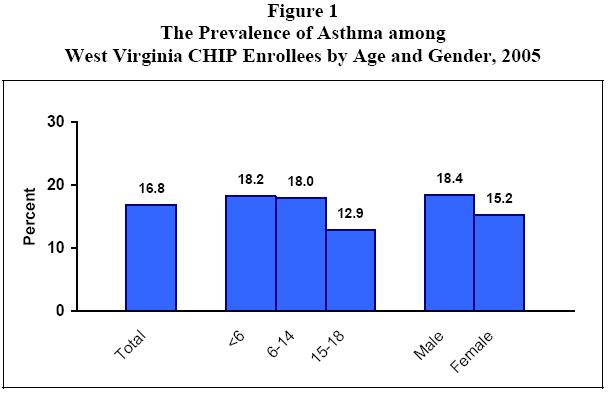
See Appendix for the methodology used to identify enrollees with asthma.
See Appendix Table A1 for more detail.
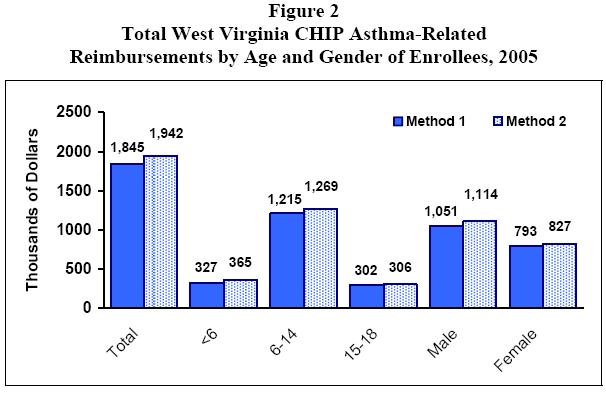
Note: Two estimates of total reimbursements for asthma are presented based on the two
different methods used to calculate hospitalization costs. See Methodology in Appendix
for a detailed discussion of these methods and Table A1 for more detailed data.
| MEDICAL SERVICES USE & COSTS |
|---|
Asthma-related medical services were defined as office/clinic visits, emergency room (ER) visits, and hospitalizations with a primary or secondary diagnosis of asthma2. In 2005, there were 5,725 office/clinic visits, 455 ER visits, and 65 hospitalizations for asthma-related illnesses among West Virginia CHIP enrollees. Male enrollees had higher rates of all types of medical services visits than females (see Figure 3, Figure 4, and Figure 5). Children under the age of six had a substantially higher rate of asthma-related hospitalizations than the older enrollees. Enrollees 15 to 18 years old had a much lower rate of office/clinic visits than the younger enrollees.
2. If an enrollee had an ER and hospital claim on the same date of service, then it was assumed that the enrollee visited the ER and then was subsequently admitted to the hospital. In this circumstance, the event was classified only as a hospitalization to avoid double counting. See Appendix for a more detailed discussion of the study methodology.
West Virginia CHIP reimbursements for asthma-related medical services totaled between approximately $750,000 and $850,000. ER visits and hospitalizations accounted for approximately one-third (28% to 36%) of this total. CHIP reimbursed an average of $95 per office/clinic visit, $267 per ER visit, and between $1,331 and $2,816 per hospitalization (see Table 2).
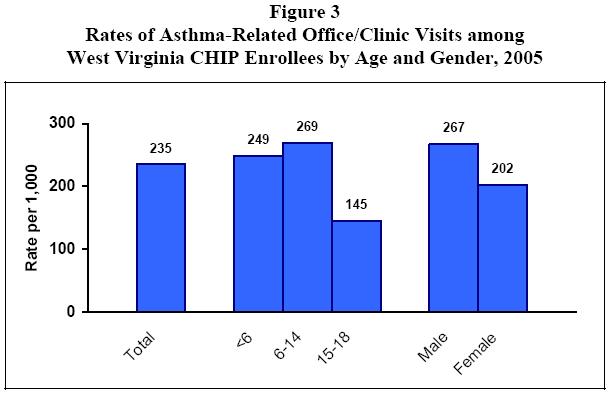
Note: Based on claims with a primary or secondary diagnosis of asthma.
See Appendix Table A2 for more detail.
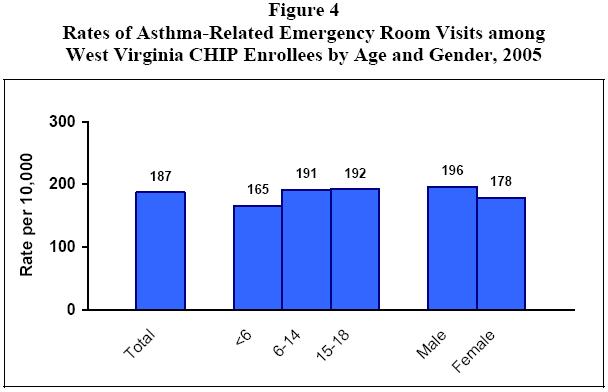
Note: Based on claims with a primary or secondary diagnosis of asthma.
See Appendix Table A3 for more detail.
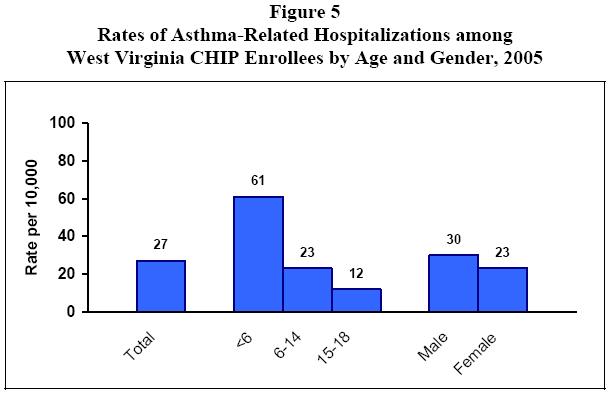
Note: Based on claims with a primary or secondary diagnosis of asthma.
See Appendix Table A4 for more detail.
Table 2.
West Virginia CHIP Reimbursements for Asthma-Related Medical Services Visits, 2005
| Medical Services | Number of Visits |
Total amount reimburseda |
Average Amount Reimbursed per Visit a |
|---|---|---|---|
| Office/Clinic Visits | 5,725 | $543,404 | $95 |
| Emergency Room Visits | 455 | $121,671 | $267 |
| Hospitalizations | 65 | $86,529 - $183,043 | $1,331 - $2,816 |
| TOTAL | 6,245 | $751,604 - $848,118 | ---- |
| PRESCRIPTION MEDICATION USE & COSTS |
|---|
In 2005, there were 2,218 West Virginia CHIP enrollees who had a medical service claim with a primary or secondary diagnosis of asthma who also had at least one prescription claim for an asthma-related medication. These enrollees had a total of 11,089 prescription claims for asthma-related medications – an average of 5 claims per enrollee with asthma (defined as having had an asthma-related medical service claim and an asthma-related prescription claim).
There are two main types of asthma medications: 1) quick-relief medications, which are used to relieve symptoms during an asthma attack, and 2) long-term controller medications, which are used to prevent attacks from occurring. Most enrollees with asthma who had filled a prescription for an asthma-related medication had received some type of quick-relief medication (see Figure 6). A higher percentage of enrollees with asthma who had filled an asthma-related prescription had received leukotriene modifiers (52.8%) than other types of controller medications.
CHIP reimbursed more than $754,000 for asthma-related medications for enrollees who had a medical service visit for asthma. The average amount reimbursed per claim was approximately $68 and the average amount reimbursed per asthma enrollee was $340. CHIP reimbursed more dollars for leukotriene modifiers than any other asthma-related class of medication ($374,924, see Figure 7).
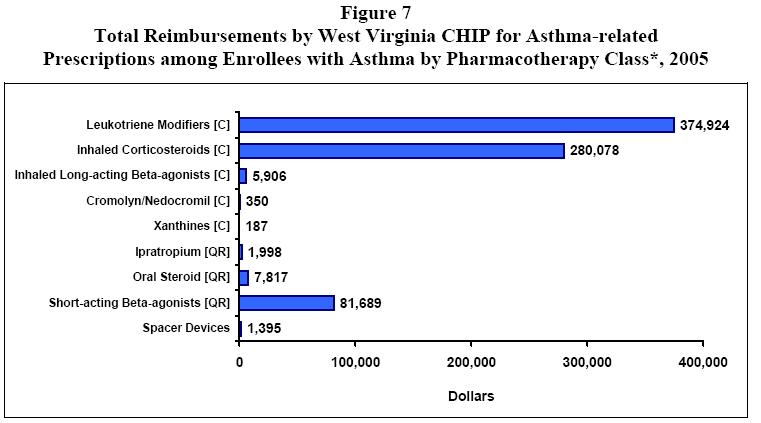
*[C] = Controller Medication; [QR] = Quick-Relief Medication.
Note: Based on enrollees with at least one medical service claim with a primary or secondary diagnosis of asthma and
at least one prescription claim for an asthma-related medication.
See Appendix Table A5 and Table A6 for more detail.
| REFERENCES |
|---|
| APPENDIX |
|---|
METHODOLOGY
Only fee-for-service paid claims data were used in this analysis. Claims data are administrative data used for billing purposes. They provide information on all medical services and prescriptions billed to CHIP for reimbursement. Disease conditions are identified by analyzing medical services diagnosis codes and prescription claims. CHIP enrollees were identified as having asthma if they had at least one medical service claim (office/clinic, ER, or hospital) with a primary or secondary diagnosis of asthma (ICD-9 CM codes 493.00-493.99), or at least two prescription claims for asthma-related drugs, of which at least one was for a drug other than an oral steroid. Oral steroids are used to treat many conditions other than asthma. Therefore, if an enrollee had a claim for an oral steroid, he/she must also have had an asthma-related prescription claim for a medication in another pharmacotherapy class to be classified as having asthma.
The definition used to identify enrollees with asthma is based on modified criteria of the National Committee for Quality Assurance (NCQA). It is important to note that this methodology may overestimate the prevalence of asthma, asthma-related medical service and prescription use, and asthma-related costs to CHIP. Specifically, medical service claims with only a secondary diagnosis of asthma are included in the rates presented in this brief, although the primary reason for obtaining treatment may be unrelated to asthma. In addition, asthma-related prescriptions are used to treat other respiratory conditions, such as emphysema and bronchitis. Diagnoses are not identified in prescription claims; therefore, it is unknown for what specific condition enrollees are being prescribed asthma-related mediations.
Each person identified with asthma was only counted once when estimating a prevalence rate, and an event (such as hospitalization) was only counted once in estimating utilization. The denominator for total prevalence rates was the number of persons enrolled in West Virginia CHIP at any time during fiscal year 2005. Data were de-identified in compliance with HIPAA regulations. This study underwent review and approval by the West Virginia University Institutional Review Board.
Amounts reimbursed by CHIP for asthma-related medical services and prescription medications were used to report total costs for asthma. Costs for ER visits, office/clinic visits, and prescription medications were based on amounts paid by CHIP that were recorded in the claims data. Costs for hospitalizations were calculated using two methods: 1) costs based on the amounts paid by CHIP that were recorded in the claims data, and 2) costs that were estimated using average diagnosis related group (DRG) reimbursement rates for 2005. Both of these hospitalization cost estimates were used to report a range of total asthma costs and asthma-related hospitalization costs.
DETAILED TABLES
Table A1.
Prevalence rates of asthma in the West Virginia CHIP population and
total CHIP reimbursements for asthma-related services – By demographic category, 2005
| Demographic variables |
Number of enrollees with asthmaa (N) |
Prevalence rate per 1,000 CHIP enrolleesb |
Total amount reimbursedc,e($) |
Average amount reimbursed per enrolleed,e ($) |
|---|---|---|---|---|
| Age (years) | ||||
| 0-5 | 772 | 182 | $327,701 - $365,945 | $424 - $474 |
| 6-14 | 2,549 | 180 | $1,215,912 - $1,269,847 | $477 - $498 |
| 15-18 | 765 | 129 | $302,056 - $306,391 | $395 - $401 |
| Gender | ||||
| Male | 2,299 | 184 | $1,051,954 - $1,114,752 | $458 - $485 |
| Female | 1,787 | 152 | $793,715 - $827,431 | $444 - $463 |
| Total | 4,086 | 168 | $1,845,669 - $1,942,183 | $452 - $475 |
Table A2.
Asthma-related office/clinic services among enrollees of West Virginia CHIP and
reimbursements by CHIP for the same – By demographic category, 2005
| Demographic variables |
Number of office/clinic visitsa (N) |
Rate of office/clinic visits per 1,000 enrolleesb |
Total amount reimbursedc($) |
Average amount reimbursed per visitd ($) |
|---|---|---|---|---|
| Age (years) | ||||
| 0-5 | 1,052 | 249 | $89,649 | $85 |
| 6-14 | 3,811 | 269 | $365,984 | $96 |
| 15-18 | 861 | 145 | $87,771 | $102 |
| Gender | ||||
| Male | 3,348 | 267 | $308,832 | $92 |
| Female | 2,377 | 202 | $234,572 | $99 |
| Total | 5,725 | 235 | $543,404 | $95 |
Table A3.
Asthma-related ER services among enrollees of West Virginia CHIP and
reimbursements by CHIP for the same – By demographic category, 2005
| Demographic variables |
Number of ER visitsa (N) |
Rate of ER visits per 10,000 enrolleesb |
Total amount reimbursedc($) |
Average amount reimbursed per visitd ($) |
|---|---|---|---|---|
| Age (years) | ||||
| 0-5 | 70 | 165 | $18,312 | $262 |
| 6-14 | 271 | 191 | $68,521 | $253 |
| 15-18 | 113 | 192 | $34,838 | $306 |
| Gender | ||||
| Male | 245 | 196 | $67,781 | $277 |
| Female | 210 | 178 | $53,890 | $257 |
| Total | 455 | 187 | $121,671 | $267 |
Table A4.
Asthma-related inpatient services among enrollees of West Virginia CHIP and
reimbursements by CHIP for the same – By demographic category, 2005
| Demographic variables |
Number of hospital visitsa (N) |
Rate of hospital visits per 10,000 enrolleesb |
Total amount reimbursedc,f($) |
Average amount reimbursed per visitd,f ($) |
Average length of stay per visite (days) |
|---|---|---|---|---|---|
| Age (years) | |||||
| 0-5 | 26 | 61 | $31,849 - $70,093 | $1,225 - $2,696 | 1.4 |
| 6-14 | 32 | 23 | $40,802 - $94,737 | $1,275 - $2,961 | 1.3 |
| 15-18 | 7 | 12 | $13,878 - $18,213 | $1,983 - $2,602 | 1.3 |
| Gender | |||||
| Male | 38 | 30 | $44,235 - $107,033 | $1,164 - $2,817 | 1.4 |
| Female | 27 | 23 | $42,294 - $76,011 | $1,566 - $2,815 | 1.2 |
| Total | 65 | 27 | $86,529 - $183,043 | $1,331 - $2,816 | 1.3 |
Table A5.
Asthma-related prescription utilization among enrollees of West Virginia CHIP with asthma and
reimbursements by CHIP for the same – By demographic category, 2005
| Demographic variables |
Number of enrollees with asthma with a prescription claim (N1)a |
Number of prescription claims (N2)b |
Average number of claims per enrolleec |
Total amount reimbursedd ($) |
Average amount reimbursed per enrolleee ($) |
|---|---|---|---|---|---|
| Age (years) | |||||
| 0-5 | 413 | 1,674 | 4.1 | $129,833 | $314 |
| 6-14 | 1,410 | 7,525 | 5.3 | $514,048 | $365 |
| 15-18 | 395 | 1,890 | 4.8 | $110,461 | $280 |
| Gender | |||||
| Male | 1,305 | 6,668 | 5.1 | $453,788 | $348 |
| Female | 913 | 4,421 | 4.8 | $300,555 | $329 |
| Total | 2,218 | 11,089 | 5.0 | $754,343 | $340 |
Table A6.
Enrollees of West Virginia CHIP with asthma, prescription claims, and
amounts reimbursed by CHIP by pharmacotherapy class, 2005
| Pharmacotherapy Class | Number (and %) of enrollees with asthmaa with a prescription claim (N1) |
Number (and %) of prescription claimsb (N2) |
Total amount reimbursedc ($) |
Average amount per claimd ($) |
||
|---|---|---|---|---|---|---|
| Spacer devices | 51 | 2.3% | 52 | 0.5% | $1,395 | 27 |
| Short-acting beta-agonists (all dosage forms) | 2,042 | 92.1% | 3,493 | 31.5% | $81,689 | $23 |
| Oral corticosteroids | 698 | 31.5% | 916 | 8.3% | $7,817 | $9 |
| Inhaled corticosteroids | 874 | 39.4% | 2,128 | 19.2% | $280,078 | $132 |
| Ipratropium | 29 | 1.3% | 35 | 0.3% | $1,998 | $57 |
| Methylxanthines | 5 | 0.2% | 8 | 0.1% | $187 | $23 |
| Inhaled Long-acting beta-agonists | 21 | 0.9% | 70 | 0.6% | $5,906 | $84 |
| Leukotriene modifiers | 1,172 | 52.8% | 4,381 | 39.5% | $374,924 | $86 |
| Cromolyn/Nedocromil | 5 | 0.2% | 6 | 0.1% | $350 | $58 |
| Total | 2,218 | 100%e | 11,089 | 100%e | $754,343 | $68 |
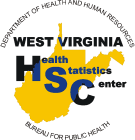
|
West Virginia Health Statistics Center |
|
350 Capitol Street, Room 165 Charleston, WV 25301-3701 Phone: (304) 558-9100 Fax: (304) 558-1787 Web: http://www.wvdhhr.org/bph/oehp/hsc/default.htm |
|
| The Health Statistics Center (HSC) maintains West Virginia vital records and conducts the Behavioral Risk Factor Survey. The HSC can do customized reports and data analysis for grants, formal research, agency use, or specific community health planning activities. For additional information call the HSC and ask for a Statistical Services staff member. Visit the HSC website for electronic access to HSC reports and statistical briefs. This publication was supported by the Cooperative Agreement number U59/CCU324180-03 from the Centers for Disease Control and Prevention. Its contents are solely the responsibility of the authors and do not necessarily represent the official views of the Centers for Disease Control and Prevention. It was produced in collaboration with the West Virginia Asthma Coalition. |
Last updated September 27, 2007.
If you have any questions, contact the Health Statistics Center at:
Phone: 304-558-9100 or
Email:dhhrvitalreg@wv.gov